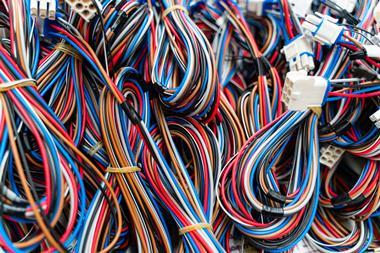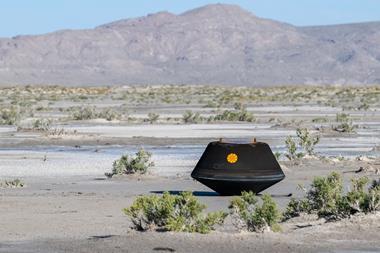Materials scientists have made transparent batteries by making electrodes so fine they are invisible to the naked eye
Energy-harvesting windows are a step closer with the development of a transparent lithium ion battery, created by US researchers at Stanford University. The electrodes are confined to a grid 35?m wide, making them too narrow to be perceived by the naked eye.
The electrodes pose the biggest challenge to transparent lithium ion batteries, as both anode and cathode materials are typically opaque. Yi Cui’s team solved this problem by making them very thin. They set the electrode materials into a grid of trenches in clear polydimethylsiloxane (PDMS). By stacking and aligning the grids with additional layers of electrodes, it is possible to increase the battery’s energy storage without sacrificing its transparency.
The Stanford team deposited a 100nm thick gold layer onto the PDMS to collect the current generated. The researchers took advantage of capillary action to pull slurries of water and electrode material - LiMn2O4 nanorods for the cathode and Li4Ti5O12 nanopowder for the anode - through the grids to create the battery’s structure.

The team then sandwiched a layer of clear electrolyte between the two electrodes, aligning the grids by hand under an optical microscope. Finally, the whole device was enclosed in a clear polymer bag, with two strips of aluminium for terminals. By varying the spacing between the trenches, the researchers achieved transparencies of 78, 60 and 30 per cent. These yielded energy densities of 5, 10, and 20 Watt hours per litre (Wh/L), respectively.
Jongseung Yoon, a nanoelectronics expert at the University of Southern California, US, says the team’s approach ’is particularly attractive as it is scalable to large areas as well as to multiple device stacks’.
This would allow a thin, energy-storing layer to extend all the way across ’smart windows’. According to Luis S?nchez of the University of C?rdoba in Spain, whose team made the first transparent electrode, this would be the chief application for transparent batteries. These devices could be combined with transparent solar cells, which have already been developed, to absorb some of the sun’s energy as it passes into a building, storing it during the day so that it can be used for low power consumption lighting after dark.
The 60 per cent transparent battery has about one tenth the energy density of the average smart phone battery, which group leader Yi Cui says can get around 100 Wh/L. ’By simple optimisation and utilisation of industrial approaches, 50 Wh/L is achievable at current stages,’ he adds.
With advanced electrode materials, he thinks it may be possible reach 150 Wh/L. And because the transparent design allows chemists to watch the reaction taking place inside the battery, studying new electrodes has never been easier.
Kate McAlpine
References
Y Yang et al, Proc. Natl Acad. Sci. USA, 2011, DOI:10.1073/pnas.1102873108






No comments yet